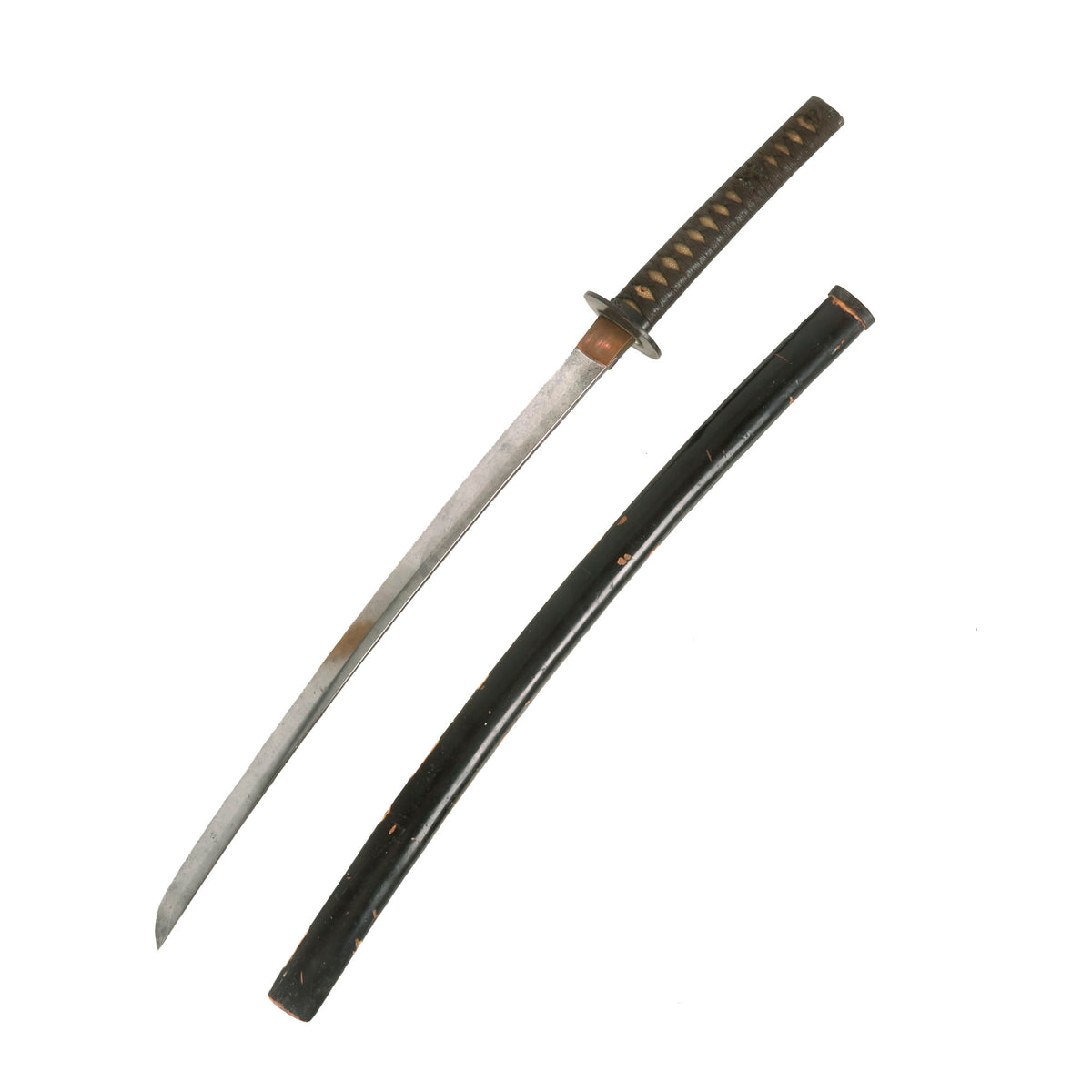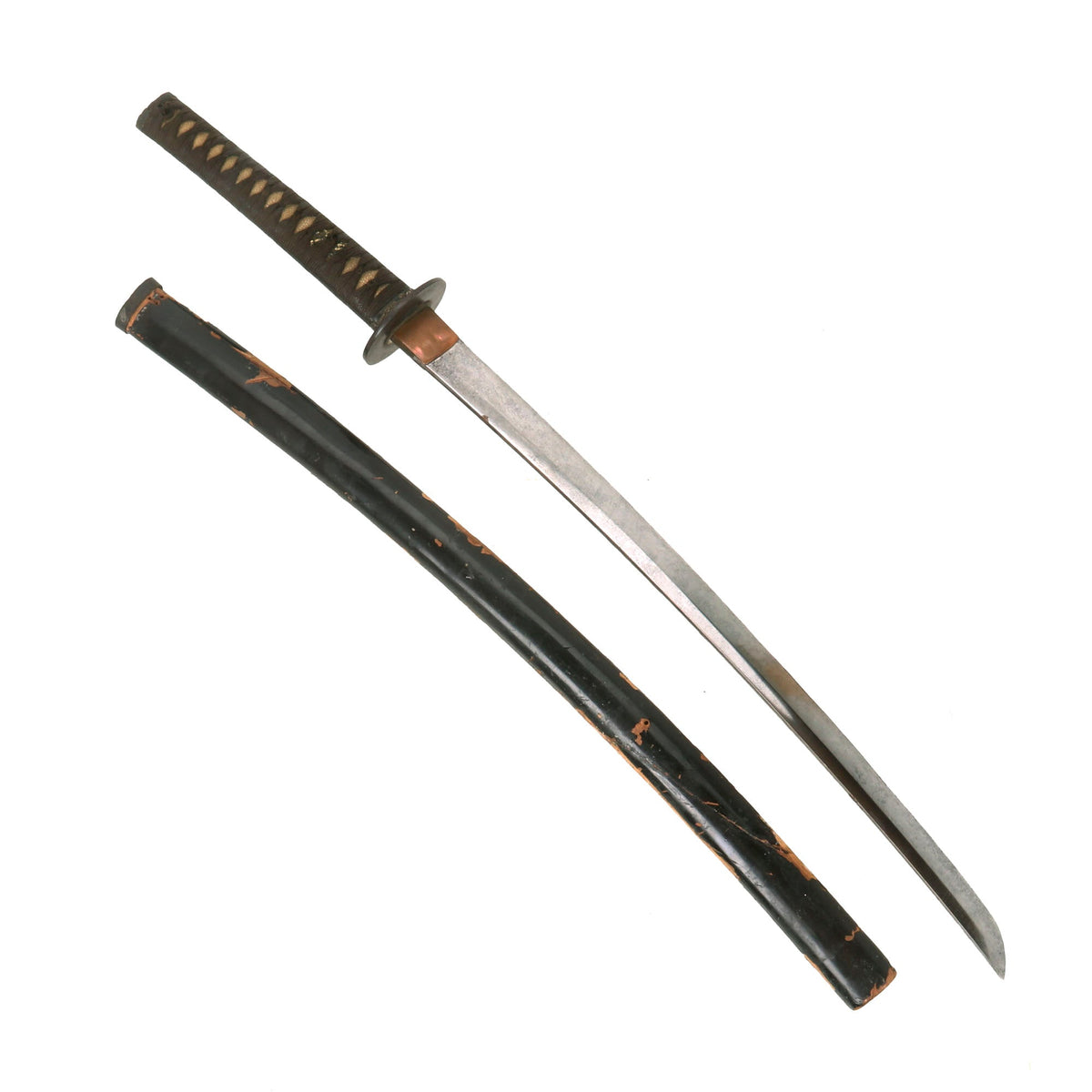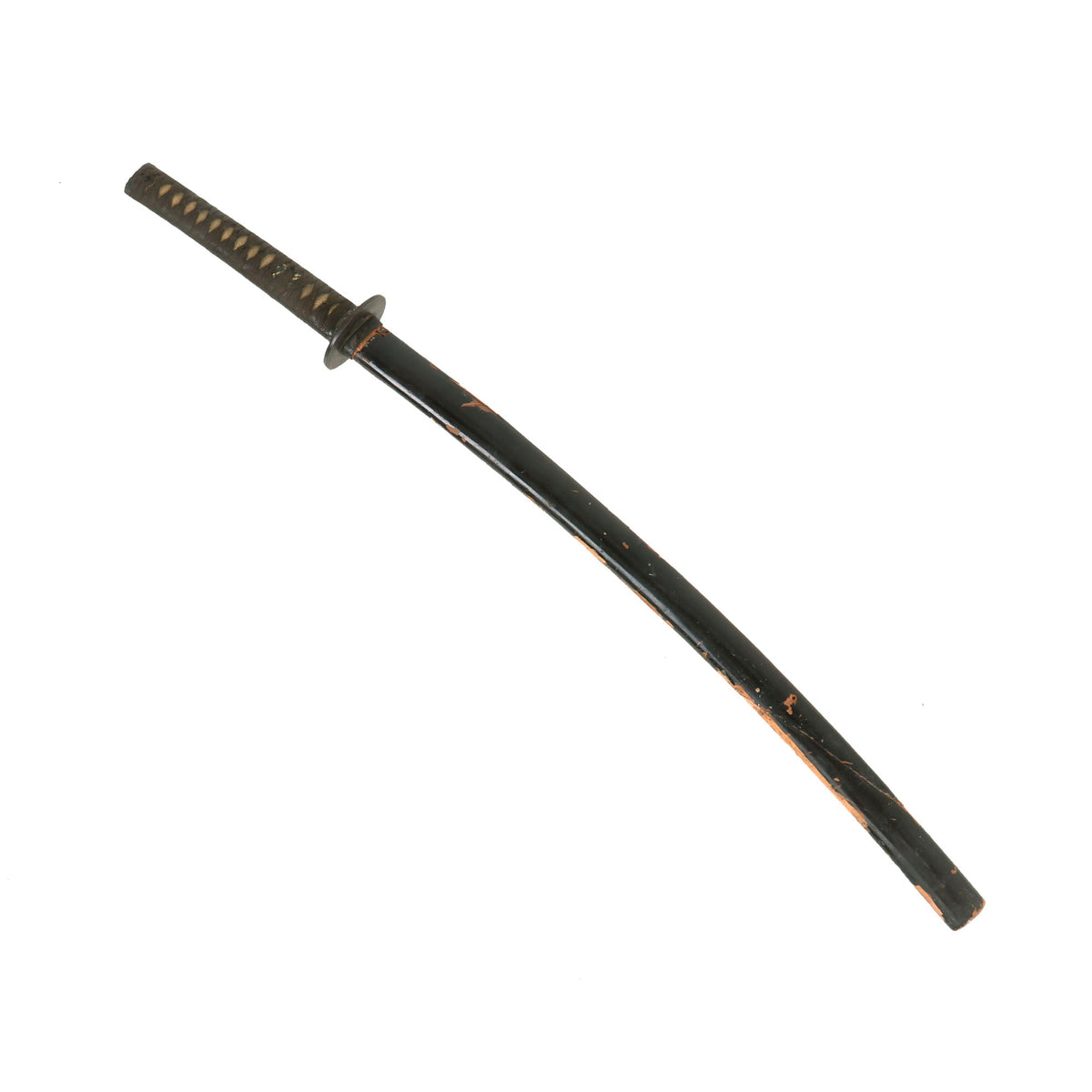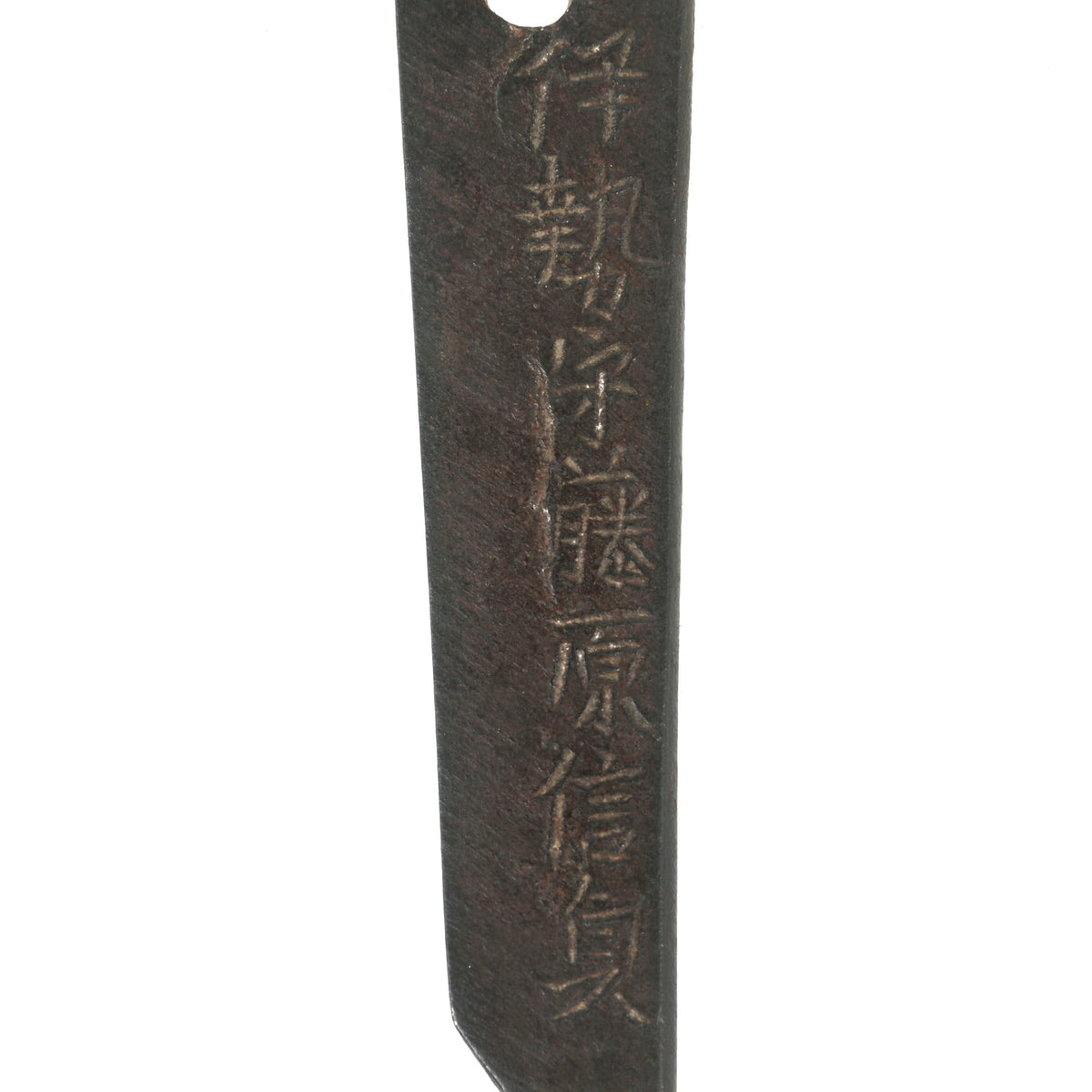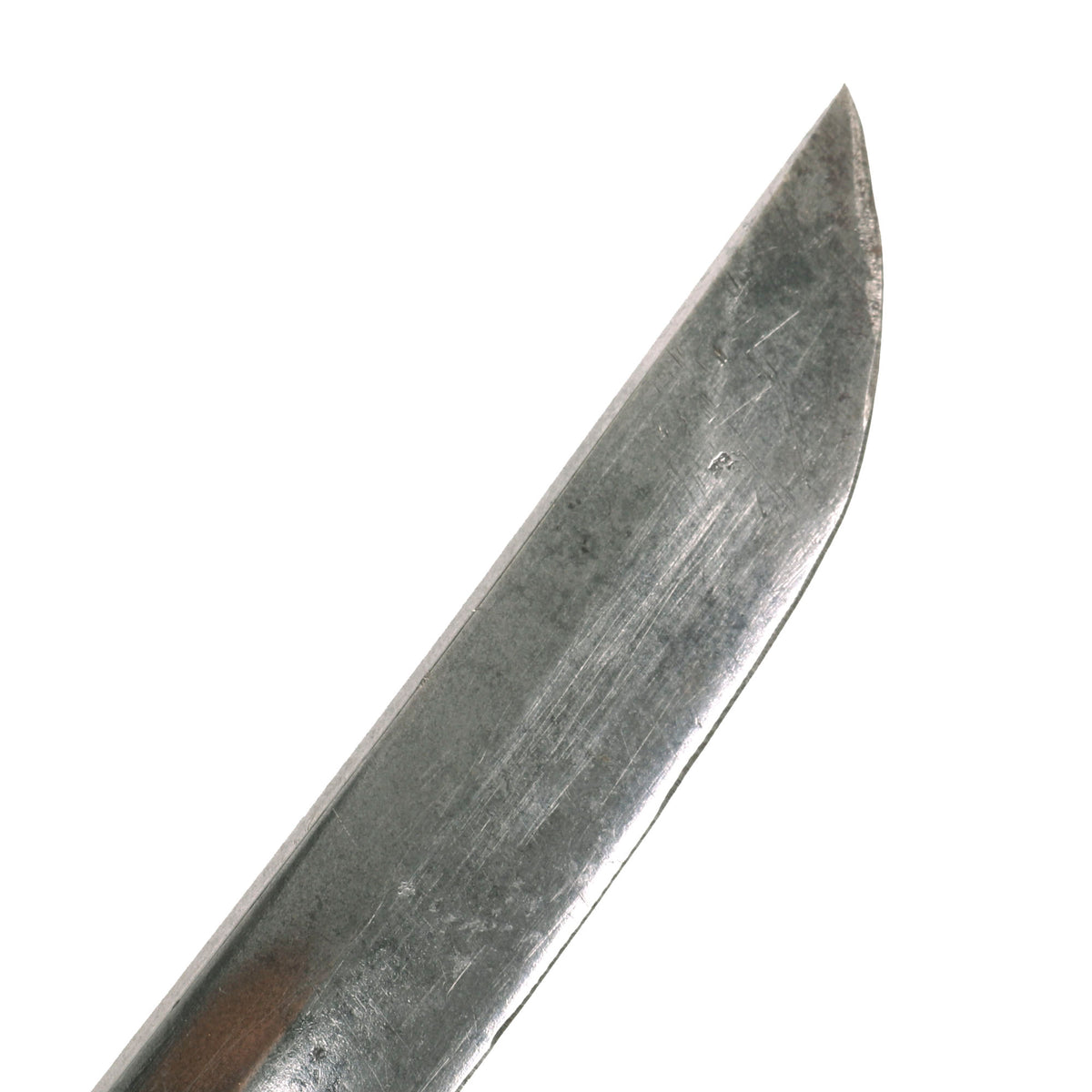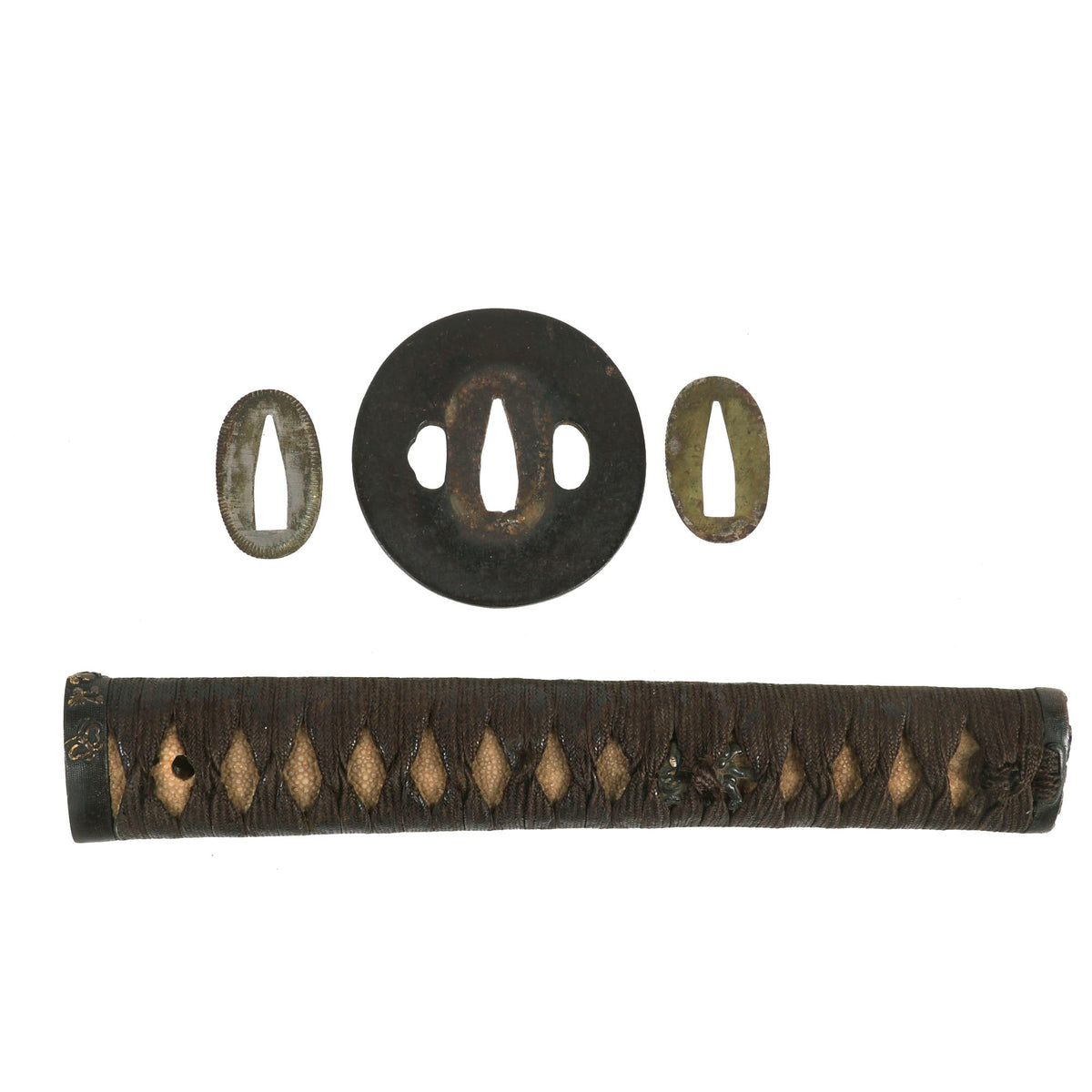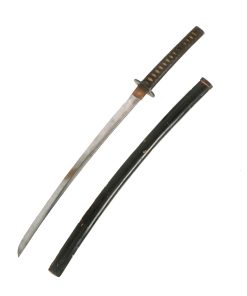Original 17th Century Early Edo Period Japanese Handmade Ō-Wakizashi Short Sword by NOBUSADA in Late Edo Fittings with Scabbard Original Items
$ 1.495,00 $ 373,75
Original Item: Only One Available. Wakizashi (脇差 “side inserted / companion sword”) is a general term for a sword with an edge between one and two shaku long (30 cm and 60 cm), predominantly made after 1600. Generally it is the short blade that accompanies a katana in the traditional samurai daisho pairing of swords, but may be worn by classes other than the samurai as a single blade, also worn edge up as the katana. Here we have a lovely service used example, which we believe was refit during the Late Edo period, and maybe even used during WWII, as indicated by the amount of wear.
This example dates from the early Edo period (江戸時代, Edo jidai) or Tokugawa period (徳川時代, Tokugawa jidai) of Japanese history. This is the period between 1603 and 1867, when Japan was under the rule of the Tokugawa shogunate and the country’s 300 regional daimyo. As the blade length is close to that of a Katana, and the blade is the “Shinogi-Zukuri” shape, some would term this an “Ō-Wakizashi”. This example has probably been remounted several times, as was common for Japanese blades that are several hundred years old, with the last time probably occurring in the late 19th Century. It was then probably brought back to the US during the WWII era.
Age and wear have made the YASURIME (鑢目 – file marks) on the tang faint, and given it a lovely patina. There still is some of the tagane-makura (raised area around the mei) present, and the tagane (chisel marks) a bit faint, and the MEI signature is still relatively easy to read. As best we can tell it reads 伊 勢 守 藤 原 信 貞 – ISE NO KAMI FUJIWARA NOBUSADA, indicating that the smith named “Nobusada” made it. The characters before this are honorific titles bestowed for good work to the smith.
Research indicates that this smith worked during the Genna (元和) and Kan’ei (寛永) eras, corresponding to 1615-1644 in the early Edo period. Nobusada worked in Mino province, a center of Japanese sword-making for centuries, and was a member of the GANMAKU school. This school was an offshoot from the JYUMYO school, one of the most prestigious in MINO. Other blades by this smith could have a slightly longer MEI, which would read Ise no Kami Fujiwara Ganmaku Nobusada(伊勢守藤原岩捲信貞), including the name of the school right before their name. We have compared the style of writing and tang shape with other examples, and as best we can tell, they match. Swords from this maker and school are highly desirable. Definitely a good opportunity for further research!
The blade has the following period correct features:
– Folded steel blade (fold lines are evident on the spine and body of the blade)
– Hole (mekugi-ana) in the tang is punched and not drilled
– Blade is signed by the maker (Mei)
– Visible temper line (“hamon”) running full length of blade cutting edge.
– Blade has a proper geometric kissaki (tip).
– Blade wounds (kizu) or lamination artifacts are present on the blade. Ware (lamination lines) are visible in several areas.
Offered in very good condition, the polish on the blade of this example is in fair condition, definitely showing wear and overall staining. It definitely looks to have been cleaned, possibly several times, since the last traditional polishing. This unfortunately makes the aspects of the blade difficult to see. The edge unfortunately looks to have suffered damage, and has been sharpened with a sharpening wheel or something similar. There is oxidation on the new edge, so this definitely happened some time ago, and unfortunately is common on WWII Era bring back blades, which most nihonto on the market are.
The blade length is approximately 20 ¾” and overall length 30 ½”. It has a futsu 普通 (regular) Nakago with an Iriyamagata (asymmetrical pointed) nakago-jiri (tang tip). The blade shape is SHINOGI-ZUKURI (鎬造), meaning the blade has a “SHINOGI” or blade ridge. This is the “standard” shape for most Katana and longer wakizashi. Many would term this an “Ō-Wakizashi” as the length is relatively close to a Katana.
The blade has a proper geometric kissaki (tip), however due to the polish condition there is no trace of the yokote (division between body and tip) or boshi (tip temper line). The main edge Temper line (刃文 – hamon) is visible in the light, and is an attractive 三盆杉 Sanbonsugi (三盆杉 – Three Cedars) shape. This is very similar to the GUNOME ( 互の目 – undulating zig zag) shape, but every third zag is higher. There are also some KIZU blade wounds visible, mostly WARE lamination lines, only possible on true handmade blades. This blade definitely has potential, as the sharpening does not go through the hamon, but it would definitely require a full restoration by a TOGISHI sword polisher.
The tsuba (cross guard) is made of iron and is of the MARU GATA (sound) shape, without any adornments visible. It has two Hitsu-ana accessory holes, one for the Kozuka (kogatana handle) and one for a kogai hair ornament. This allows the accessories to be taken out without unsheathing the sword, though neither are included in this setting. There are two metal seppa to help keep the tsuba from wobbling. The sword has a copper blade collar (habaki), typical of the Edo period.
The fuchi (collar) for the tsuka (handle) is made from blacked copper, and has some lovely floral and butterfly designs. The kashira (end cap) is matching, with the same embossed floral designs. There are two menuki grip ornaments, which look to be some type of animal. The stingray skin (Sa-Me) grip is in great shape, showing no splitting or other damage, and the brown grip wrapping (Ito) shows some wear and staining from use.There is a single wooden securing peg (mekugi) still present which looks to be a recent replacement.
The sword comes well-fitting wooden scabbard (saya), which is finished with gloss black or dark brown urushi lacquer. The scabbard is relatively unadorned, and does not have any accessory slots or even a kurikata knob. The koiguchi scabbard mouth is iron with embossed brass designs. Condition definitely looks like the scabbard sawa a lot of use, possibly put into service during WWII. It has splits along the seams, chipped lacquer, and a repaired crack near the bottom on one side. There is also some wood missing near the throat.
A very nice service used early Edo Period wakizashi by a well-regarded smith with a nice set of Edo period fittings! Ready to research and display!
Specifications:
Blade Length: 20 ¾”
Blade Shape: Shinogi-Zukuri (鎬造)
Overall length: 30 ½“
Scabbard Length: 25 ⅜”
It has been over one thousand years ago that the art of making swords appeared in Japan. The swordsmiths of the time may not have known it but they were creating a legendary sword. The Samurai sword has seen combat in many battlefields. From the early days of the Samurai warrior to the fierce battles in the South Pacific during WWII.
Each hand-made Japanese blade (日本刀 – Nihonto) is unique because it is forged from multiple pieces of folded steel stock. A tremendous amount of work is dedicated to creating these pieces. They were an instrument of war as much as a beautiful artifact to adorn a room.
The traditional Japanese blade and mountings have grown to be one of the most highly desired military antiques.
Fast Shipping with Professional Packaging
Thanks to our longstanding association with UPS FedEx DHL, and other major international carriers, we are able to provide a range of shipping options. Our warehouse staff is expertly trained and will wrap your products according to our exact and precise specifications. Prior to shipping, your goods will be thoroughly examined and securely secured. We ship to thousands clients each day across multiple countries. This shows how we're dedicated to be the largest retailer on the internet. Warehouses and distribution centres can be located throughout Europe as well as the USA.
Note: Orders with more than one item will be assigned a processing date depending on the item.
Before shipping before shipping, we'll conduct a thorough inspection of the items you have ordered. Today, the majority of orders will be delivered within 48 hours. The delivery time will be between 3-7 days.
Returns
The stock is dynamic and we cannot completely manage it because multiple stakeholders are involved, including our factory and warehouse. So the actual stock may alter at any time. It's possible that you may not receive your order once the order has been made.
Our policy is valid for a period of 30 days. If you don't receive the product within 30 days, we are not able to issue a refund or an exchange.
You can only return an item if it is unused and in the same state as the day you received it. You must have the item in its original packaging.
Related products
Uncategorized
Uncategorized
Uncategorized
Uncategorized
Uncategorized
Uncategorized
Uncategorized
Uncategorized
Uncategorized
Uncategorized
Uncategorized
Armored Burgonet Helmet & Polearm from Scottish Castle Leith Hall Circa 1700 Original Items
Uncategorized
Angolan Rebel 1970s era 60mm Inert Display Mortar from Angolan Civil War Original Items
Uncategorized
Uncategorized
Uncategorized
Uncategorized
Uncategorized
Uncategorized
Uncategorized
Uncategorized
Band of Brothers ORIGINAL GERMAN WWII Le. F.H. 18 10.5cm ARTILLERY PIECE Original Items
Uncategorized
Uncategorized
Australian WWII Owen MK1 Machine Carbine SMG Custom Fabricated Replica with Sling Original Items
